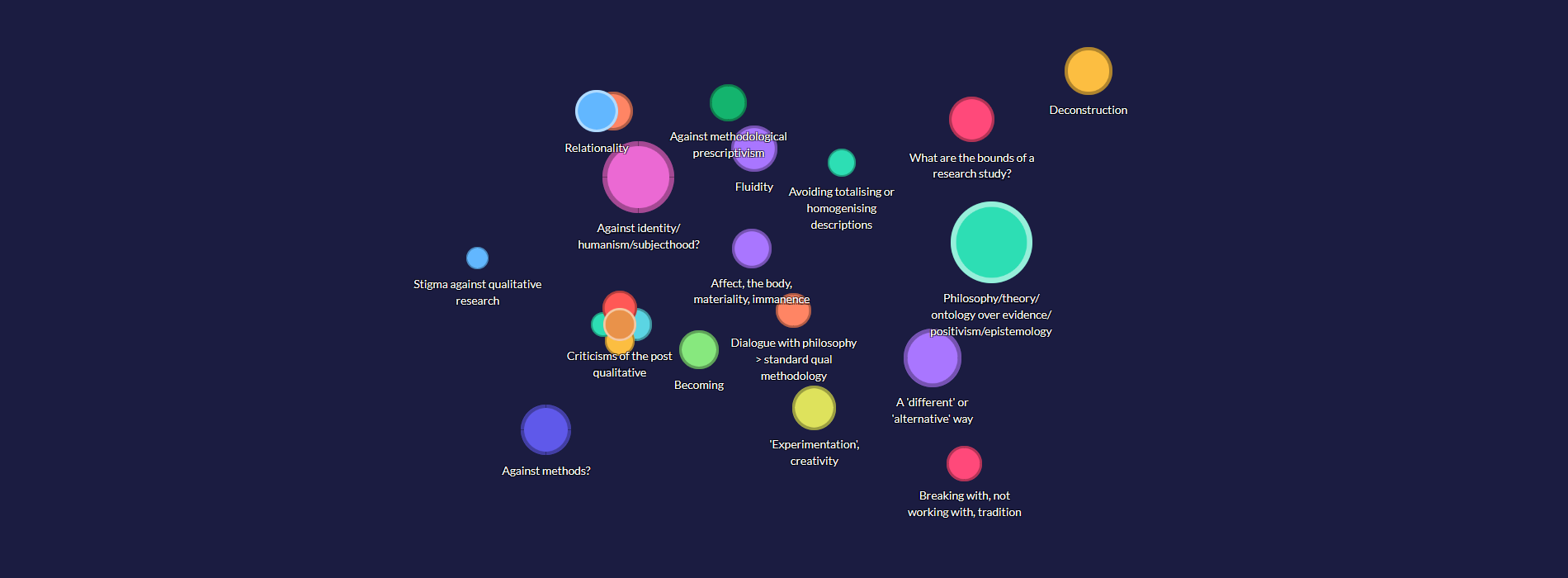Beyond coding: using qualitative software in a post qualitative way

This post is part 2 of a two-part blog on post qualitative inquiry. If you want to know more about the post qualitative, visit our first post here.
Is post qualitative inquiry incompatible with qualitative data analysis software?
Most computer assisted qualitative data analysis software (CAQDAS) is designed for coding – that is, assigning passages of text to categories to compartmentalise it for further analysis. If you are coding for this purpose, you are unlikely to be doing post qualitative inquiry. St. Pierre (2023) suggests that coding is an arbitrary practice. The possible associations of a given sentence are too vast to close off into categories. This work may preclude deeper thought about texts, by separating you from the work of deeply reading the text, much too soon. If you're trying to do deconstruction, creating new, possibly arbitrary categories risks enclosing your sources in new structures.
But is there any place for CAQDAS in post qualitative inquiry at all? Flexible and creative software programs have a better chance of being helpful, by not locking you into a specific analytical method. For instance, we have gone into some of the ways that you can avoid coding in standardised ways (or at all!) in Quirkos. Reading theory deeply is difficult, but software can bring improvements to the process that do not structure your effective analysis and inquiry for you. In most cases, it would not obstruct deep analysis to be able to navigate sources in one place and use the software to help with drawing connections between sources, and saving those connections so you don't forget them. If anything, this would be helpful for the aims of post-qualitative inquiry to be far-reaching and appreciative of the complexities and interrelationality of the world.
For this reason, I used Quirkos to traverse my sources and prepare to write this blog series. I decided it was useful to follow my initial impulse to 'understand' or 'make sense of' the reading, even though this wasn't especially post qualitative – so, I did code my sources, but acknowledged I may break with coding at some point in the process. I used memos to note passages which seemed especially important or connected – which I think had the biggest impact on the post. Coding divided off the most interesting passages into sections, and allowed me to connect the texts based on their broad 'themes', but the definitions of the quirks grew to be incredibly broad and far reaching. I kept finding myself renaming and adding related concepts to single quirks, as seen above. This had the effect of showing me the incompleteness of coding when it is taken in isolation, as an end in and of itself – and that 'making full sense' of post qualitative inquiry may have always been an impossible end goal for my blog post.
It was my memos that pointed me towards the most interesting and provocative claims of my sources, and allowed me to position myself (and the other sources) in relation to them. Because the memos in Quirkos annotate the texts, this prevents you from losing the broader context of your comment and the highlighted passage of text (more on this here). Keeping your notes in a separate document or program risks leading you away from a productive dialogue with your sources, where you can acknowledge their impact on you and your research. Describing the post qualitative approach, St. Pierre (2023) emphasises the necessity of being transformed and shaped by the philosophical texts you read. I would argue that placing your notes in combination with (instead of 'above', or 'isolated from') the texts, helps to facilitate this process. As a bonus, annotating your texts like this helps you to interrogate what your sources are saying and question your own understanding, rather than producing a summarised facsimile that may lose the original nuances. Scrawling your observations onto print-outs would make this rather difficult (and would use up a lot of paper!), but software makes this form of analysis a lot more practical.
Whether I was coding or using memos, Quirkos helped me to more consciously see my role in mediating between the texts, and the ways that my own observations became, themselves, a text of their own. I bring this up to suggest that coding doesn't have to be an isolated attempt to make sense of reality, boxing it in. In my case it helped me to identify my own biases and presuppositions around the post qualitative, so that I might deconstruct them when I came to write later.
This blog series is not unbiased. The first post summarises the ideas of post qualitative inquiry, but also their most common criticisms. This post advocates for some methods which many post qualitative inquirers have discarded completely, and of course discusses our own software as a potentially useful intervention. I would like to clarify my own position. As a researcher, I am much more embedded in the humanities than the social sciences. My degrees are in literary and cultural studies, and I produced many theoretical, philosophical and poststructuralist papers. I would therefore consider my scholarly work closer to post qualitative inquiry than to conventional qualitative studies. The anti-methodological stance of a lot of post qualitative inquiry is unusual to me, because as students we were often encouraged to see our theoretical stance as our methodology. Despite this difference in wording, I doubt that our work in literary theory would be considered too positivist.
With all of this in mind, it might say something that upon discovering qualitative software, I was struck by the clunkiness of my existing methods of reading and analysing texts – specifically, attempting to account for the infinite possible connections between them. I realised how much more time I could have spent reading deeply, thinking about texts and developing my own analysis, instead of attempting to organise the vast amount of philosophical texts so that I could actually complete that reading. It reminded me that software is a tool, and that the best software for academic inquiry gets out of the way, without imposing a specific methodology. I think that any piece of software which is flexible, permits creativity and experimentation, and doesn't impose a methodology, can provide an extension to post qualitative thinking. The best kind of software doesn't provide any shortcuts for reading closely or thinking deeply (in fact, we've written about the worrying implications of automating analysis here), but it can make the prospect of managing vast amounts of theory less intimidating, and ultimately make philosophy and post qualitative inquiry more accessible.
If you are interested in interrogating your own relationship with theory like I did, you can get a free 14-day trial of Quirkos here!
References
St. Pierre, E. A. (2023). Poststructuralism and Post Qualitative Inquiry: What Can and Must Be Thought. Qualitative Inquiry, 29(1), 20–32. https://doi.org/10.1177/10778004221122282
